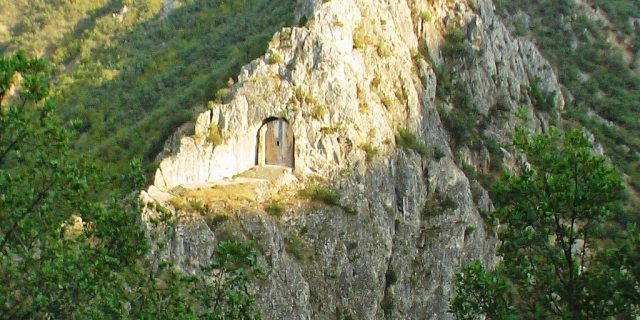Alacahöyük
( Alaca Höyük )Alacahöyük or Alaca Höyük (sometimes also spelled as Alacahüyük, Euyuk, or Evuk) is the site of a Neolithic and Hittite settlement and is an important archaeological site. It is situated near the village of Alacahüyük in the Alaca District of Çorum Province, Turkey, northeast of Boğazkale (formerly and more familiarly Boğazköy), where the ancient capital city Hattusa of the Hittite Empire was situated. Its Hittite name is unknown: connections with Arinna, Tawiniya, and Zippalanda have all been suggested.
 The Sphinx Gate
The Sphinx GateThe mound (Turkish höyük) at Alacahöyük was a scene of settlement in a continuous sequence of development from the Chalcolithic Age, when earliest copper tools appeared alongside the use of stone tools.
Bronze AgeDuring the Early Bronze Age, the mound was the center of a flourishing culture. It has been continuously occupied ever since, until today's modern settlement in the form of a small village. The standing and distinguishing remains at Alaca Höyük, however, such as the "Sphinx Gate", date from the Hittite period that followed the Hatti, from the fourteenth century BC.
 A royal tomb in Alaca Höyük
A royal tomb in Alaca Höyük Artifacts from Alaca Höyük
Artifacts from Alaca HöyükFourteen shaft-grave "Royal Tombs" (2850–2450 BC) date to the same period as the Royal Tombs of Ur and the Troy excavation level II. The tombs of typical shaft design, about 1.5 meters in depth, sealed by wooden beams, They contained the dead with folded legs facing west. The heads and legs of bulls were placed on platforms and the dead were richly adorned with gold fibulae, diadems, and belt buckles and repoussé gold-leaf figures. Seven metal figurines were found in the tombs with four being made of bronze and 3 of silver.[1]
Tomb H - (8 meters by 3.4 meters), female. Contents included "a golden diadem, two copper mace heads, a bronze sun standard, the statuette of an animal, small ornaments made of gold and silver, vessels made of gold and clay, metal artefacts, two axes, five pairs of twin idols made of gold, and three female figurines".Tombs A - (5 meters by 2.3 meters), adult female. Besides a golden diadem contents included "four sun standards, an animal statuette, several metal ornaments, pieces of an iron object, and two metal anthropomorphic figurines ". The Sphinx Gate detail
The Sphinx Gate detail The Sphinx Gate detail
The Sphinx Gate detailMany of the artefacts discovered at Alacahöyük, including magnificent gold and bronze objects found in the Royal Tombs, are housed today in the Museum of Anatolian Civilizations in Ankara. Among these artefacts are gold and electrum standing cups and other vessels. The most unusual are the Alaca Höyük bronze standards; bulls or stags on pedestals whose purpose remains the subject of debate. The standards are cast in copper, many in the form of flat circles, half-circles or squares that are filled with an openwork network of cross bars, central crosses, and swastikas. Leonard Woolley[2] found that the Royal Tombs "seem to belong to the end of a period, as marked by a stratum of destruction and the burning of the citadel. The culture which the tomb objects illustrate does not continue into the next historical phase, that of Kültepe". Modern assessment[3] finds that the site continued as a flourishing community to the end of the Late Bronze Age. There was also a sizable occupation in Phrygian times.
DamsA dam, dating from 1240 BC, was announced to be reopened for use on September 23, 2006. The dam was ordered by King Tudhaliya IV in the name of the goddess Hebat. According to ancient Hittite tablets, a drought struck Anatolia in 1200 BC, prompting the King to import wheat from Egypt so that his land would avoid famine. Following this, the king ordered numerous dams to be built in central Anatolia, all but one of them becoming non-functional over time. The one in Alacahöyük has survived because the water source is located inside the dam's reservoir.



























Add new comment